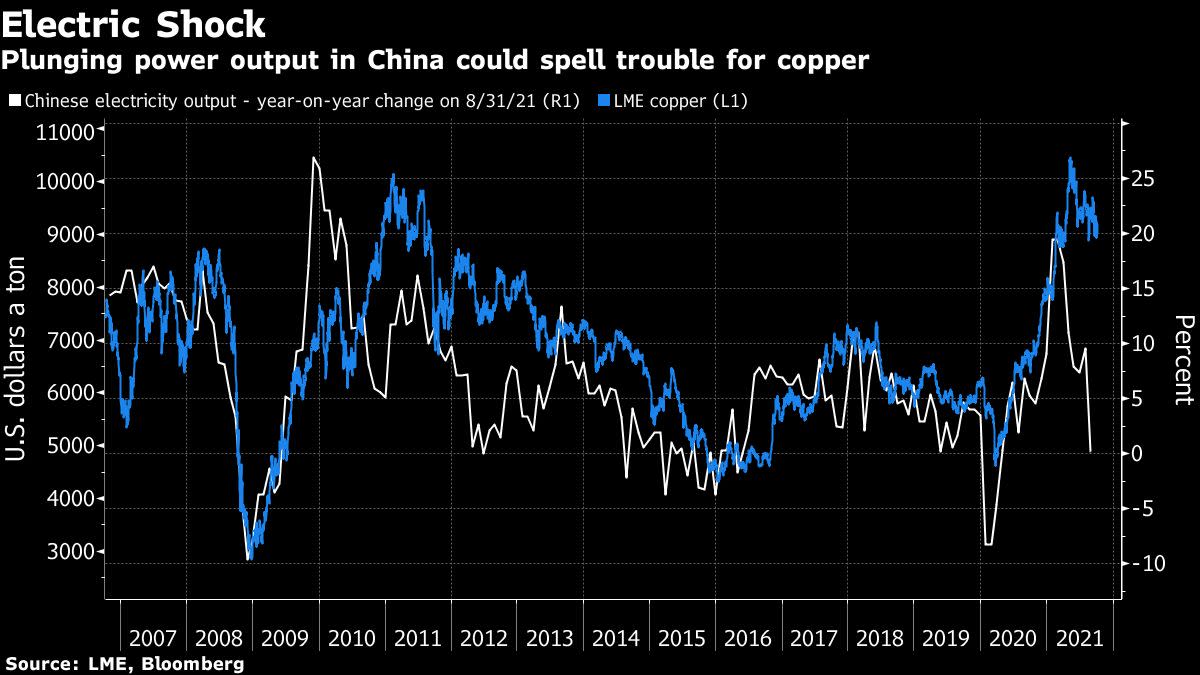Copper Bulls Get Electric Shock as World’s Factories Slow Down

(Bloomberg) — The global energy crisis is casting a pall over copper, as investors who are bullish on its long-term prospects fret that power shortages and factory slowdowns could trigger a retreat in the near term.
Most Read from Bloomberg
As a reliable gauge of economic health, copper is fast becoming a canary in the coal mine for analysts and academics, who fear that the surging costs of natural gas and electricity will send markets reeling. That could unleash a bout of stagflation, where demand from consumers and manufacturers craters but the costs of goods and raw materials remain stubbornly high.
Yet energy isn’t the only weight on copper, a metal that’s essential for builders, automakers and electronics manufacturers. The risk of a collapse in China’s debt-addled property sector plus the ongoing economic threat posed by Covid-19’s delta variant are prompting investors to pull back and wait it out on the sidelines – at least for now.
“In the short term there are some headwinds, mainly due to concerns about China’s economy,” said Jay Tatum, portfolio manager at New York-based Valent Asset Management. “But once the world gets back to normal growth rates, evenly spread across the economy, we still think there’s a strong case to be made for metals like copper.”
Copper’s blistering rally above $10,700 a ton came in May as lockdown restrictions sparked insatiable demand for metals in housing and consumer goods. Numerous traders and banks bet that prices would increase even more, theorizing that the manufacturing boom would dovetail into long-term plans for electric vehicles and renewable energy.
Bank of America Corp. said $20,000 could be possible if major supply-side issues arose simultaneously.
Instead, copper has dropped to about $9,300 as China’s property crisis and the delta variant roiled markets. And then came the energy crisis, with economies emerging from the pandemic thirsting for coal, gas and renewables while supplies fell short. Citigroup Inc. — one of the biggest cheerleaders for copper earlier this year — now warns that prices could fall another 10%, with demand shrinking over the next three months.
“What tipped me over the edge in terms of becoming outright bearish was the power, coal and gas crisis,” said Max Layton, managing director for commodities research at Citigroup in London. “The concern is that it gets a lot worse.”
On Friday, biggest-consumer China said it will allow 20% increases in power prices for energy-intensive companies, and most of its provinces are limiting electricity use. Manufacturing activity contracted last month for the first time since the pandemic began.
In Europe, a gauge by IHS Markit that measures business activity in manufacturing fell last month by the biggest margin since April 2020 — the beginning of the pandemic. Growth in new orders, output and employment slowed considerably after companies such as CF Industries, Yara International ASA and BASF SE said they’d be reducing production because energy was too expensive.
With spot copper demand still holding up well for now, the default stance among investors appears to be inertia. Speculative positioning in both London and New York contracts has pulled back to pre-pandemic levels, though prices remain about 50% higher than at the end of 2019 and were trading at $9,368 a ton.
So far, fears about widespread industrial brownouts have yet to be realized. A measure of U.S. manufacturing expanded in September at the fastest pace in four months, with 17 industries reporting growth. Congress also is debating President Joe Biden’s economic agenda that earmarks more than $1 trillion in domestic spending.
For Trafigura Group, the world’s largest copper trader, its confidence in the outlook for prices remains sky high, as demand strength continues and the world runs increasingly low on inventories. And while the risks that an energy crunch will hit manufacturers are growing, so far it’s seen a greater impact on the supply of copper as energy-intensive smelters have dialed back.
“Macro headwinds aside, if you look at the speed that stocks are drawing globally, it’s clear that the market is facing significant tightness,” Kostas Bintas, head of copper trading, said from Geneva. “It was the micro picture that made us right last time, and it’s the micro picture that gives us confidence now.”
Some traders stress that the short-term pain of the power crisis could prove to be a fillip in the future if it galvanizes politicians and businesses to invest in renewable-energy systems requiring huge amounts of copper. Most countries have released plans for reaching net-zero carbon emissions in the coming decades.
“The market is feeling more and more like we’re loading a spring,” Valent’s Tatum said. “The longer we load the spring, the more pronounced the reaction will be.”
Most Read from Bloomberg Businessweek
©2021 Bloomberg L.P.




